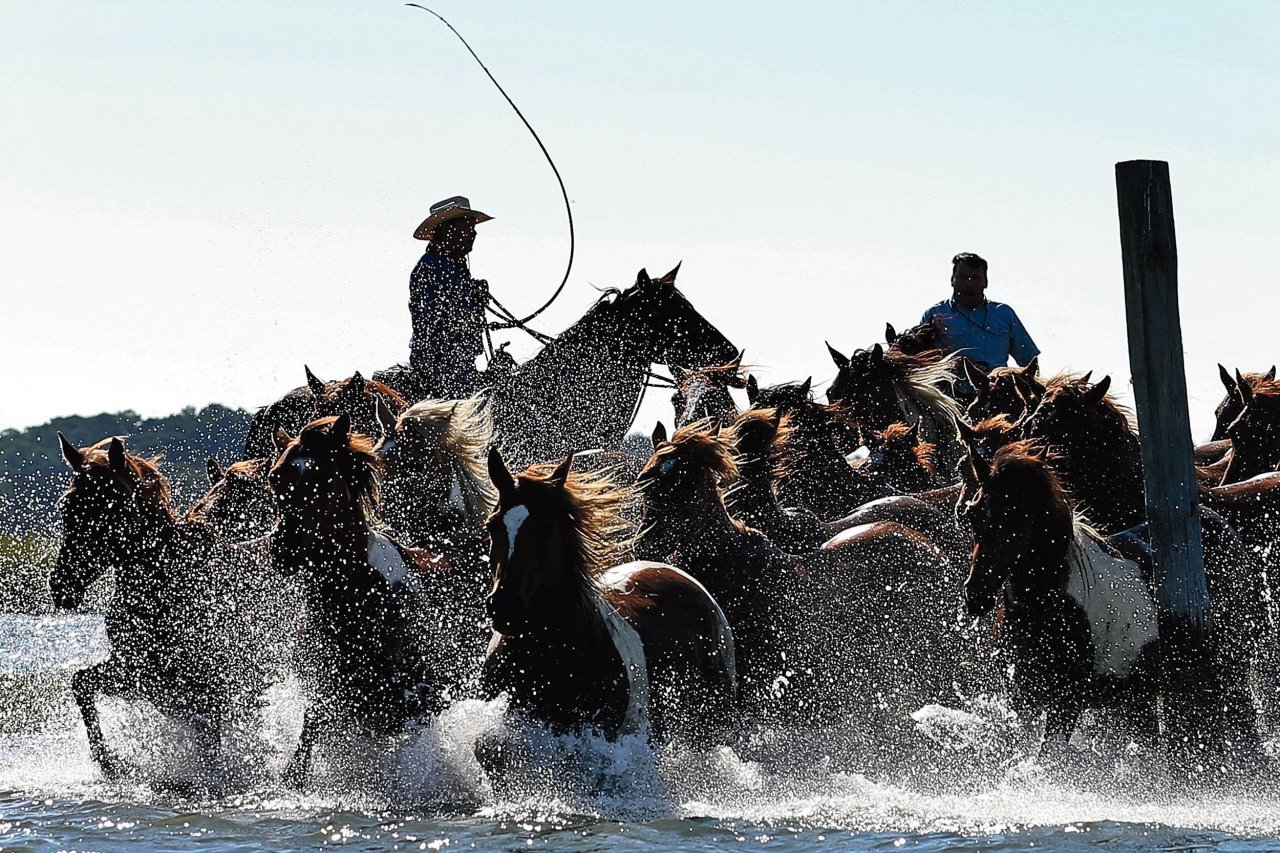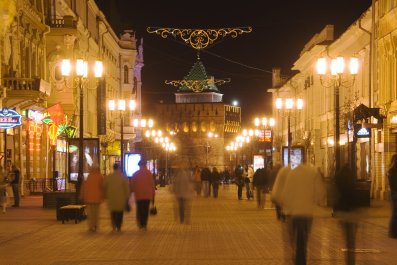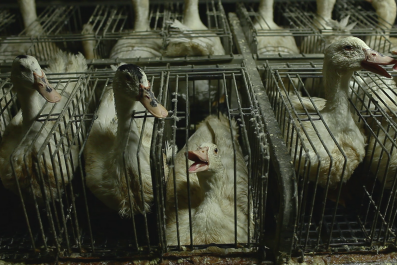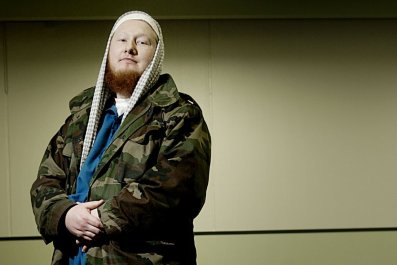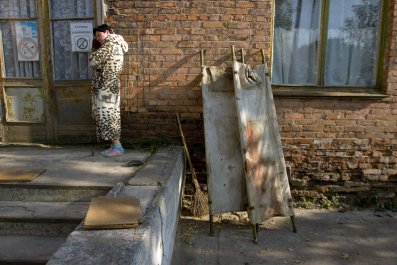A flare cuts an orange incision into the clear sky above the channel that separates the Assateague and Chincoteague islands. The signal comes just before noon to announce that slack tide, when the water is still, has finally arrived in this basin. A little boy in cowboy boots sits perilously close to the edge of a dock, craning his thin neck for a better view of the horizon. A young girl's voice rises from somewhere in the mud alongside the dock. She wails, "I'm hungry," but her voice is quickly swallowed by the din. A woman on the dock, clearly a local—there's a fire-hat-wearing pony tattooed on her ankle—raspily complains to her friend about impatient spectators, recalling one thusly: "He said, 'You can't pinpoint the time any better than that?'"
"The time" is when the ponies will suddenly come surging out of the water. Some 40,000 worn and weary people are waiting for them to show, and the damn ponies are running late. They were supposed to arrive once slack tide, a somewhat unpredictable time of day, hit, and that was several long moments ago. The spectators are mostly patient and polite—we are in the South—though some can't help but elbow and step on one another as they jostle for a better view of the ocean. As the wait drags on, many onlookers grow impatient and wade deeper into the marsh, where fuchsia-tinged jellyfish, some as large as fat housecats, undulate undetected until an unsuspecting pilgrim gets stung. Paramedics stand by because the pony-tourists, many of whom have been waiting here since dawn without enough food or water, have been known to faint.
Play Misty for Them
Chincoteague Island, population 2,956, is a humid strip of land off the coast of Virginia that covers just nine square miles of dry Earth. Main Street is lined with mail-order kit houses that Sears, Roebuck and Co. sold from approximately 1908 to 1940. On the commercial stretch of this thoroughfare, some blocks smell richly of Old Bay seasoning, owing to the seafood restaurants specializing in Chesapeake crab. Coastal Living awarded Chincoteague the title of "America's Happiest Seaside Town" of 2014. Until a few years ago, the only chain on Chincoteague was a McDonald's, one resident tells me. There is no evidence that those two facts are related. And none to disprove it.
Things are changing, though. There's now a Subway restaurant, for starters. Mom-and-pop motels, which used to have virtually all of Chincoteague's guest accommodations, have started selling out to chains. Even the greasy spoons now offer gluten-free options. It wouldn't be surprising if the pies and shortcakes at next year's Blueberry Festival, one of Chincoteague's most important cultural events, were supplanted with faddish "superfoods" such as chia seeds and quinoa.
Yet tradition endures in the form of the Chincoteague Pony Swim.
Each July, on the last Wednesday of the month, approximately 26 of the 100 or so Chincoteague Volunteer Fire Company (C.V.F.C.) members swim more than 150 ponies from Chincoteague National Wildlife Refuge, on Assateague Island, to Chincoteague. It's the water-loving, feral pony equivalent of a cattle drive. Several days before the swim, ponies are driven into a corral on the water's edge; come swim day, the "World Famous" Saltwater Cowboys, as they are called, open the corral gates and lead them through the water to Chincoteague Island. The day after the swim, the C.V.F.C. sells most of the foals at auction, to raise money for the department. The next day, the same group of volunteer firefighters and some longtime supporters swim the few remaining foals, as well as the adolescent and adult ponies, back to the refuge.
The Pony Swim is in its 89th year, but its roots go much further back, to approximately the 1700s, when locals celebrated the yearly roundup of loose livestock. Nobody is sure how the ponies first got to Chincoteague, but the most popular theory is that they were cargo on a shipwrecked Spanish galleon.
The C.V.F.C. got involved in 1925, several years after fires destroyed much of the town. The volunteers needed new gear, so the company decided to host a fund-raising carnival during Pony Penning Week. A few decades later, the C.V.F.C. had enough cash to purchase its own ponies (and, in turn, raise more money), which it then grazed on the wildlife refuge. The grazing permit allows for 150 animals to graze there.
Today, Pony Penning Week—popularized internationally with the 1947 publication of Marguerite Henry's beloved children's novel Misty of Chincoteague, and the 1961 movie Misty—is still a fund-raiser for the department and an excellent way to keep the wild pony population under that 150 limit. (Misty, a Chincoteague pony that Henry adopted, inspiring the book, died in 1972, but she is stuffed and displayed at the Museum of Chincoteague in all her white-gold grandeur.) The island's population swells to more than 10 times its number during the roundup, swim and auction.
One third-generation Saltwater Cowboy, who at age 21 has already been swimming the ponies to Chincoteague for six years, says participating in the week's festivities brings him and like-minded Teaguers—pronounced "Tiggers," it's what Chincoteague natives call themselves—closer together. "You're a part of history," he says. "There's not many people who get to do this job."
Jennie Eley, who lives in nearby Greenbackville but was born and raised on the island, puts it this way: "In Chincoteague, there are two holidays: Pony Penning Week and Christmas."
Banners draped on the town's streetlights feature artful depictions of these petite horses, and declare Chincoteague "Home of the Ponies." The local trolley is called "The Pony Express." The high school mascot? The Ponies. Around town, several motels have their own penned ponies. Several members of the C.V.F.C. even have pony-themed tattoos rather than the typical flames-and-skulls firefighter ink. And while the Chincoteague Pony Centre might not seem like much more than equine kitsch to an outsider, its two nightly shows—featuring a pony dressed as a lion that drinks a can of Coke—are packed during Swim season.
The Sewer Savior
The key problem facing Chincoteague isn't one of identity; it's one of sustainability. Can something so quaint and slow-paced as an aquatic pony roundup stay relevant in our tech-obsessed, instant-gratification culture?
Global warming also poses a threat. A U.S. Fish and Wildlife Service document says the Mid-Atlantic region has sea-level rise rates of 2.4 to 4.4 millimeters per year. Assateague is already threatened by erosion from that rate, and the island is also at risk of migrating landward and breaking into smaller sections over time. Fish and Wildlife Service experts want to move the public beach north, where they believe the beach is more stable, but locals worry that will hurt tourism by making visits to Assateague more cumbersome. "It's an event that a lot of the businesses depend on," Evelyn Shotwell, executive director of Chincoteague's Chamber of Commerce, tells Newsweek.
Overdevelopment, the kind that changes cute seaside towns into high-rise-packed destinations, also worries Chincoteague, since "quaint" is a big part of its appeal. "Somehow, we've been able to keep that," Shotwell says. "Perhaps it's as simple as the fact that we don't have a public sewer system. That may sound crazy, but all of our septic system is still individually, privately owned septic systems. We can't have anything over a three-story-tall building because of that. That has helped us…maintain our small-town character."
White Foam Rising
On Pony Swim day, back on the dock, there isn't any talk of septic tanks—let alone whether they might be the town's savior. In fact, the exact reason why this tradition persists, and seems safe for the foreseeable future, isn't all that important. What is important is that right when the water stirs, the crowd immediately jolts to attention—just as the crowd has done in years past—in anticipation of this event.
A crest of white foam is rising on the horizon. It's finally time. Hundreds of heads, all long and regal, bob up and down in the water, appearing larger as they near land.
Children, many knee-deep in the sulfurous muck, gasp and clap and shout. Ponies!
And just as they have done on so many Pony Swim days past, men on horses gallop hard alongside the approaching ponies, cracking whips to scare rebels who dare to stray from the string. Snorts and whinnies intensify as the ponies charge forward, churning the brackish water. As they approach the shore, their water-matted manes and tails slap back and forth, as if they are trying to break free from a tyrannical bridle. Their goal: a small patch of marsh grass surrounded by a sea of camera lenses and smartphones.
The water thins. The ponies emerge in a sudden, steady stream of stallions and mares and yearlings and foals. Their velvety, muscular bodies, expanding and contracting rapidly with short breaths, are white and black and brown and blond. Some even have the ever-prized black-and-white paint markings, which give the ponies coloring not unlike Holstein Friesian cows. Those paints, with their big patches, are sure to fetch a high price at auction the next day.



